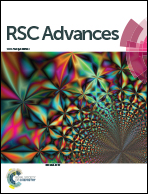Upconversion luminescence of cerium-stabilized high temperature phase zirconia phosphors with a high Er3+ doping concentration
Abstract
Oxide upconversion (UC) materials usually have lower luminescence efficiency (LE) due to their low quenching concentration and high phonon energy. To solve this issue, we have investigated in detail cerium-stabilized high temperature phase zirconia based phosphors (Zr(0.85−x)Ce0.15O(2−0.5x):xEr3+) with different doping concentrations of Er3+ and have achieved a red phosphor with an Er3+ concentration as high as 10 mol%, which will have broad prospects for its application as a new UC material. The results demonstrate that adjusting the host structure of the UC material can increase its quenching concentration and thereby the LE will be improved. The introduction of Ce4+ into ZrO2 not only stabilizes its phase but also improves the LE of the ZrO2 based UC material. The Er3+ coordination state changes with an increase of Er3+ concentration in the UC phosphors based on cerium-stabilized zirconia. The corresponding luminescence process translates into the cross relaxation from the excited state absorption, UC luminescence changes from green to red and the red emission intensity becomes stronger and stronger and achieves its maximum when the Er3+ concentration is 10 mol%.


 Please wait while we load your content...
Please wait while we load your content...